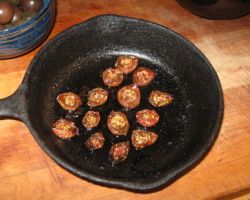 |
 |
|||
Culinary AdvancesSeptember 28, 2010 Recently I copyedited a book about wine tourism in California. We don't have wine tourism on Martha's Vineyard: the only winery was closed in 2008 and the vineyard land sold to the filthy rich people who already owned the designer farm next door. Needless to say, they are not running a winery. The late George and Cathy Mathiesen, who founded Chicama Vineyards in 1971, encouraged hikers, joggers, horseback riders, and cyclists to use the dirt road through the vineyard. Among the first acts of the new owners were the erection of fences and the locking of gates so that no one could cut through. But I digress . . . The Vineyard's relationship with tourism is like a drunk's relationship with booze: it makes his life miserable, but he can't live without it. (The same can probably said for most "tourist destinations," not to mention most of our jobs.) So I'm curious about this thing we're addicted to. What motivates people to turn tourist? What are they looking for? The wine tourism book I worked on offered plenty of insight, much of it delivered in first-person narratives by people working in wineries, restaurants, and other tourist-attracting concerns. (It would have offered more if the authors had known enough about tourist-trap life to ask better questions. I could digress at some length about that, but not right now.) So in California wine country, tourists pay big bucks for oenological (that means "related to wine") and gastronomic adventures. One of these gastronomic adventures is pâté de foie gras. I'd heard of pâté de foie gras ("fat liver pâté") but didn't know exactly what it was. According to the book, a California law passed earlier in the decade outlawed the selling of fat liver pâté after 2012. I looked it up and was grossed out in about two seconds, even though I have no special fondness for geese. The goose livers are fattened by force-feeding the geese far more food than they would consume on their own. The chefs and consumers of fat liver pâté, of course, claim that the discomfort to the geese is minimal, and if the geese end up dead, wouldn't that happen if the entrée were roast goose? Everyone's the hero of their own story, as I'm so fond of saying, and that includes tourists and the people who make their livings serving tourists. (It also includes alcoholics, but once again I digress.) My question is, Does craving for pâté de foie gras occur in the wild? Are some people born with it, or does it maybe appear at puberty along with secondary sex characteristics? My theory is no; it's an acquired taste. Even people who love it at first taste could almost certainly live without it. I love Nutrageous bars and Sierra Nevada Pale Ale, but I can go several days without either. A person who organized his or her life around the obtaining and consumption of pâté de foie gras would, quite justifiably, be seen as a fanatic. But people do acquire a strong enough taste for pâté de foie gras that they will pay a lot of money for the pleasure of eating it, and even the compassionate animal-lovers among them will come to tolerate the force-feeding of geese in order to obtain abnormally fat livers. I, on the other hand, don't see the point in acquiring tastes that are going to cost me big bucks to satisfy. I wasn't introduced to lobster at a young age, and when I first tasted it, I couldn't understand what the fuss was about. When I turn down lobster, people stare. If I say, "I don't like it," I'm told I haven't given it a chance. This is true -- why should I? If lobster were cheap and readily available, sure: I'm sure I could acquire a taste for lobster. Since it's neither, I'll pass. I am not, however, the gastronomic equivalent of tone-deaf. My palate can discriminate among all sorts of tastes, and sometimes it's the gastronomic equivalent of orgasmic. Sunday, for instance, I made hummus. I love hummus, but I don't often buy it because it ain't cheap. How hard could it be to make hummus? The hardest part turned out to be finding tahini at the upscale grocery store. It turned out to be shelved next to the peanut butter, where I wouldn't have thought to look if a cashier hadn't pointed me in that direction. By the time I was done, my blender was threatening to go on strike, but my hummus is delicious. Hummus spread on sourdough raisin toast? Oh my. Back in Puritan days, such self-indulgence would have got me locked in the stocks.
Hummus on toast. No chickpeas were killed, tortured, or even inconvenienced in the making of this dish. Earlier this month, I discovered the wonders of slow-dried cherry tomatoes. Yesterday I halved about a dozen, put them in a cast-iron skillet, and left it in a 250-degree oven for about two and a half hours. When done they looked like this:
The plan was to use them in the quiche that I was going to make later in the day. Trouble is, by suppertime I'd eaten them all. This is why I'm not trying to acquire a taste for lobster, pâté de fois gras, or $100 wine. Once upon a time I had a tourist's taste for Martha's Vineyard. Now Martha's Vineyard is just hummus on toast.
|
||||
Home - Writing - Editing - About Susanna - Bloggery - Articles - Poems - Contact Copyright ©
Susanna J. Sturgis. All rights reserved. |
||||

